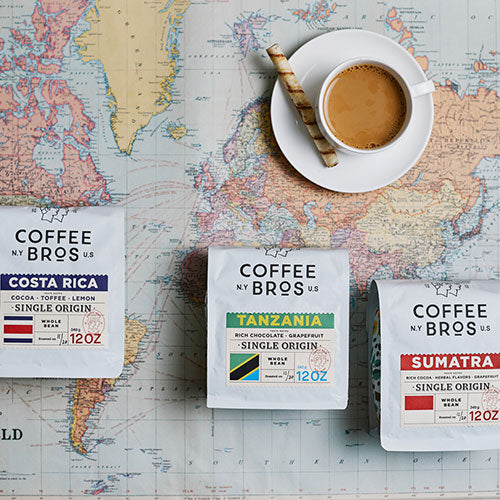Uncovering the Origins Behind Specialty SOE Single Origin Espresso
Wiki Article
Coffee Beans 101: Everything You Need to Know Concerning Espresso and Blended Coffee Beans
When it pertains to coffee, recognizing the subtleties of coffee and combined beans can change your day-to-day cup. You'll find the unique features of Arabica and Robusta beans, and exactly how each influences flavor and high levels of caffeine content. From the expanding procedure to toasting strategies, every step contributes in your coffee experience. So, what makes the best brew? Allow's explore the vital aspects that contribute to an exceptional mug of coffee.Comprehending Coffee Beans: Ranges and kinds
When diving right into the world of coffee, recognizing the kinds and selections of coffee beans is crucial for every fanatic. You'll primarily come across 2 major types: Arabica and Robusta. Arabica beans are recognized for their smooth, intricate tastes and lower caffeine web content, making them a favored among coffee fanatics. On the various other hand, Robusta beans load a punch with a stronger, more bitter taste and higher high levels of caffeine degrees, typically utilized in espresso blends.Within these species, you'll discover numerous regional selections, each bringing distinct features. Ethiopian Yirgacheffe supplies bright floral notes, while Colombian beans supply a healthy taste profile. As you explore, remember to take notice of processing methods like cleaned or all-natural, as they can significantly affect the final preference. By acquainting yourself with these beans and their flavors, you'll boost your coffee experience and make even more enlightened selections in your brewing trip.
The Growing Refine: From Seed to Bean
When you explore the trip of coffee, everything beginnings with seed choice techniques that set the foundation for top quality. From there, growing and harvesting play crucial functions in ensuring the beans grow. Ultimately, processing techniques change those collected cherries right into the coffee beans you like.Seed Option Strategies
Selecting the ideal seeds is important for producing high-quality coffee beans, as it lays the foundation for the whole growing procedure. You ought to start by selecting seeds from trustworthy sources that focus on quality and genetic diversity. Try to find ranges known to flourish in your specific environment and dirt problems. Focus on the seed's age and storage space problems, as fresh seeds tend to sprout far better. When feasible, go with natural seeds to decrease exposure to unsafe chemicals. Consider the illness resistance of various selections, as this can significantly influence your yield. Do not be reluctant to consult with regional farmers or professionals to obtain understandings into the ideal seed choices for your region. This expertise will boost your coffee-growing experience.Farming and Harvesting
As you nurture your coffee seeds into thriving plants, recognizing the growing and harvesting process is crucial for accomplishing the best taste and top quality. Begin by growing your seeds in well-draining soil, ideally in a shaded location to shield them from direct sunlight. As your plants expand, maintain constant wetness, and bear in mind their demand for nutrients. Prune consistently to advertise air flow and healthy development.When it comes time to harvest, look for ripe cherries, which normally transform a vivid red. Hand-picking is typically the best approach to ensure only the ripest cherries are chosen. Timing is vital; collecting also late or as well early can influence the taste profile of your beans. Embrace perseverance and care, as this is where high quality begins.

Processing Approaches Discussed
Once you have actually harvested your coffee cherries, the following essential action is processing them to transform those lively fruits right into the beans you'll brew. There are 2 primary techniques: the wet procedure and the completely dry process. In the dry process, you spread the cherries out in the sun to dry, enabling the fruit to ferment and give distinct flavors to the beans. On the other hand, the damp process includes getting rid of the fruit promptly and fermenting the beans in water, causing a cleaner preference. After handling, the beans are hulled, sorted, and usually dried again. Each technique influences the taste profile, so explore both can aid you discover your favored mixture. Recognizing these techniques is key to enjoying your coffee experience.Roasting Strategies: Just How Taste Is Developed
When it concerns toasting coffee beans, comprehending roast levels is crucial to disclosing their special flavors. Each roasting method influences the scent and enhances the flavor advancement procedure, offering you a richer coffee experience. Allow's discover how these aspects integrated to raise your day-to-day mixture.Roast Levels Described
Roast levels play an essential role in forming the flavor profile of your coffee. By understanding these degrees, you can better choose a coffee that matches your taste choices. Experiment with different roasts to find which one reverberates with you, boosting your overall coffee experience and enjoyment.Influence on Fragrance
The roast degree not only affects the taste of your coffee yet additionally considerably affects its scent. When you choose a light roast, you'll usually discover brilliant, flower notes that can make your coffee odor lively and fresh. As the beans dim, the scent changes; a tool roast brings out more balanced, caramelized fragrances, while a dark roast tends to include vibrant, smoky undertones. Each roasting strategy releases various unstable substances, shaping just how your coffee smells. In addition, the freshness of the beans plays a critical function; newly baked coffee launches a lot more fragrant oils, improving that luring fragrance. Pay interest to the roast degree-- it's key to exposing the complete fragrant experience of your mixture.Flavor Growth Refine
As you discover the taste development process, you'll uncover that roasting methods play an essential duty in shaping the preference account of your coffee. The toasting temperature and time directly influence the acidity, sweet taste, and anger of the beans. Light roasts retain more of the bean's initial tastes, highlighting fruity and flower notes. Medium roasts balance level of acidity and body, supplying a well-rounded flavor. Dark roasts, on the various other hand, draw out bold, great smoky attributes while decreasing the bean's fundamental top qualities. During toasting, chemical reactions, like the Maillard response and caramelization, transform the beans and boost their intricacy. Trying out with various roasting degrees can help you discover your ideal brew, so don't be reluctant to taste and uncover the rich range of flavors!Espresso vs. Blended Coffee: Trick Differences
Coffee and blended coffee each deal unique experiences that deal with different preferences and choices. Espresso is a concentrated coffee made by requiring hot water via finely-ground coffee beans, causing an abundant, bold taste and a luscious layer of crema on top. It's commonly enjoyed as a shot or utilized as a base for drinks like lattes and coffees.On the other hand, mixed coffee incorporates different beans from different areas, creating a more balanced taste profile. You'll usually locate blends that highlight sweetness, body, or acidity, making them functional for different brewing techniques. While coffee concentrates on strength, combined coffee might offer a more comprehensive series of flavors that can transform with each sip.
Eventually, your option in between espresso and combined coffee boils down to your personal choice. Whether you hunger for a leisurely cup or a quick jolt, both options have something delicious to supply.

Brewing Approaches: Opening the Perfect Mug
When it involves brewing coffee, discovering the right technique can change your experience and boost your cup. Each developing method has its special beauty and can significantly impact your coffee's taste and fragrance. As an example, making use of a French press enables SOE you to take pleasure in a rich and robust mixture, while a pour-over method gives a tidy, intense cup with unique tastes.If you favor coffee, buying a top quality machine can assist you grasp the art of pulling shots. Alternatively, for convenience, a single-serve pod system provides rate without giving up taste.
Don't forget about chilly mixture, which delivers a smooth, much less acidic coffee suitable for warm days. Experiment with different approaches to find what resonates with your palate.
Sampling Notes: Recognizing Flavor Profiles
How can you genuinely value your coffee if you don't recognize what tastes to look for? Sampling notes are your guide to understanding the complicated world of coffee. When you drink, focus on the preliminary tastes that strike your taste. You might identify fruity notes, like berry or citrus, or perhaps a nutty undertone. As you remain to taste, observe exactly how the tastes advance-- this is understood as the "coating." Some coffees might leave a chocolatey or caramel aftertaste, while others might have a bright, clean coating.Consider the body of the coffee, also; is it ventilated and light or thick and syrupy? Do not forget acidity; a brilliant level of acidity can include activity, while a low acidity may give a smoother experience. By recognizing these taste accounts, you'll deepen your connection with each mug, making coffee sampling a delightful journey of discovery.

Tips for Picking and Storage Coffee Beans
Keeping and selecting coffee beans correctly can greatly enhance your brewing experience. Beginning by selecting top notch beans that suit your preference - SOE.When you have your beans, store them in an impermeable container to stop direct exposure to light, air, and moisture. A dark, amazing place works best, so avoid maintaining them in the refrigerator or freezer, as this can present moisture. Only grind the quantity you require to preserve freshness; whole beans retain flavor longer than pre-ground coffee.
Finally, attempt to utilize your beans within two to four weeks after opening up for peak preference. Adhering to these pointers will ensure your coffee remains savory and delightful, boosting your day-to-day mixture to brand-new heights.
Regularly Asked Concerns
For How Long Do Coffee Beans Stay Fresh After Toasting?
Coffee beans remain fresh for about 2 weeks after roasting - SOE. You should keep them in a closed container, far from light and dampness. Afterwards, their flavor and scent start to decrease significantly
Can I Mix Different Coffee Bean Varieties?
Absolutely, you can mix various coffee bean selections! Explore blends can boost flavors and develop an unique taste profile. Just make certain to stabilize the toughness and characteristics of each variety for the very best results.What Is the Suitable Grind Dimension for Espresso?
For coffee, you'll want a fine work size, concerning the structure of common salt. This permits perfect removal, causing an abundant, savory shot. Experiment a little bit to discover what matches your preference best!How Does Altitude Affect Coffee Bean Flavor?
Altitude influences coffee bean flavor by affecting the growth rate and chemical make-up. Higher altitudes cause slower maturation, which enhances level of acidity and intricacy, giving your coffee a vivid and one-of-a-kind taste you will not fail to remember.Are There Decaffeinated Versions of Coffee Beans?
Yes, there are decaffeinated variations of coffee beans. You can enjoy an abundant espresso taste without the caffeine kick. Just search for "decaf" blends at your local coffee bar or specialty store.Coffee Beans 101: Everything You Need to Know Regarding Coffee and Blended Coffee Beans.
When diving right into the world of coffee, understanding the types and ranges of coffee beans is vital for every enthusiast.When it comes to roasting coffee beans, understanding roast degrees is crucial to disclosing their unique flavors. Espresso is a concentrated coffee brewed by requiring hot water via finely-ground coffee beans, resulting in an abundant, strong flavor and a creamy layer of crema on top.On the other hand, blended coffee incorporates different beans from various regions, producing a much more balanced taste profile.
Report this wiki page